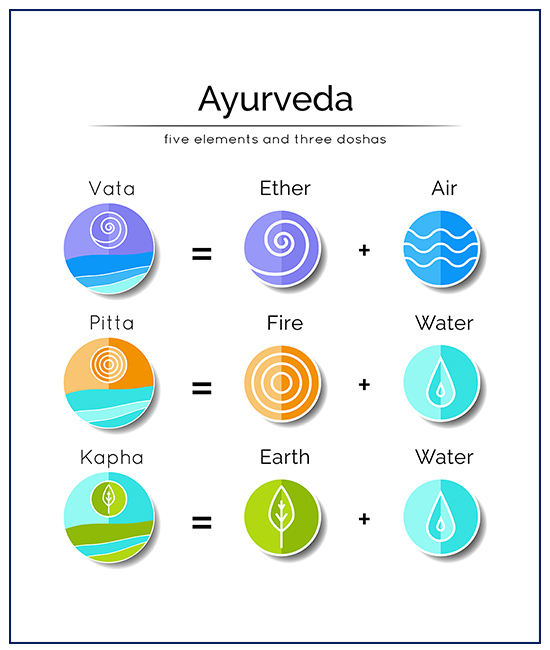AYURVEDA
Ayurveda is the medicine that has stood the test of time, with the aim of preserving health and eliminating disease from the root. Taken birth in India several thousands of years ago, a congregation of Rishis from the Himalayas passed on this ancient knowledge orally to a lineage of sages and created the oldest written texts in Ayurveda: The Charaka Samhita, Sushruta Samhita, and the Ashtanga Hrudaya. Ayurveda has journeyed around the world to the Chinese, Tibetans, Greeks, Romans, Egyptians and Persian Civilizations.
We are living in a modern era where people’s lifestyles are a whirlwind of chaos, our five senses are bombarded and as a result there is a disruption to the natural rhythm of life.
Ayurveda is that which brings us back to the rhythm of nature. Ayur means “life” and Veda is “the science” Recognising that the science of life is embedded in nature’s elements – PanchaMahaBhoota: earth, water, fire, air and space and that the elements are part of our very existence.
In times of global warming and environmental disruption, mankind is questioning the relationship between having a healthy earth and having a healthy mind and body. Ayurveda insists that within natures balance lies all the remedies for good health.
Today there are many misconceptions about Ayurveda, such as, it takes a long time, the medicines contain heavy metals which are harmful to the body, that it cannot be utilized in acute care medicine, or that it is unsafe. By experiencing the authenticity of the Ayurvedic knowledge and practices, such misconceptions will fail to arise. Click here to view some more myths and facts about Ayurveda.
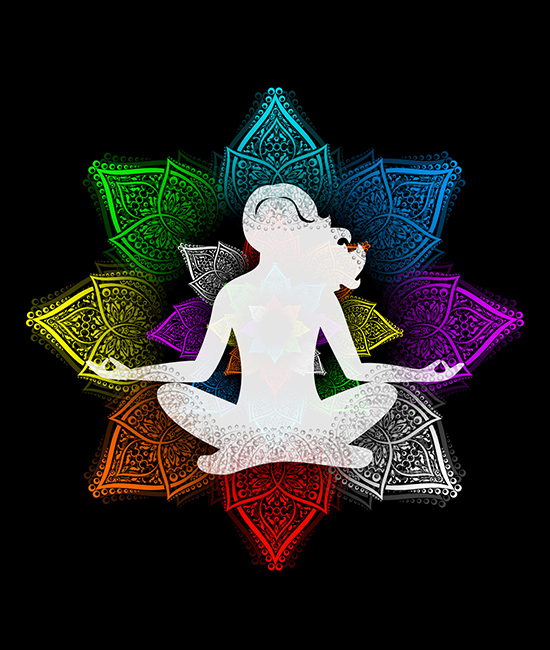
A FRESH BREATH OF AYURVEDA
Life has four characteristics:
It exists, evolves, expresses and extinguishes. And for these, it depends on five elements: the earth, water, air, ether and fire. These correspond to the five senses: sight, smell, taste, sound and touch.
According to Ayurveda, life or existence is not rigid compartments - it is a harmonious flow. Even the five elements are not tight compartments of defined objects - they flow into one another. Each one of the elements contains the other four. So, the approach of Ayurveda towards life is holistic.
The subtlest element in us is space, which the mind is made up of, and the grossest element is the earth, which our bones, skin and body structure are made up of. To understand the physiology, its characteristics and its reflection on the mind, the human system is divided into three doshas (TRI DOSHAS/ Vital Humors) or imbalances. The Tridoshas (tri meaning three and doshas being the basic physical energies) are the primary and essential factors of the human body that govern our entire physical structure and function. Derived from the Panchmahabhutas, each dosha - which like the elements cannot be detected with our senses but their qualities can be – is a combination of any two of the five bhutas with the predominance of one. Called Vata, Pitta and Kapha in Sanskrit, these three are responsible for all the physiological and psychological processes within the body and mind – dynamic forces that determine growth and decay. Every physical characteristic, mental capacity and the emotional tendency of a human being can therefore be explained in terms of the tridoshas.
FUNCTIONS OF TRIDOSHAS
It provides following functions -
- All movements of body (both physical & mental) - including respiration, heartbeat, movements of bones & muscles, Movement of food; movement of thoughts.
- All eliminations: fetus, semen, feces, urine, sweat & others
- Assists with all the various metabolisms in the body (called Agni in Ayurveda)
- Relays all sensory input from the various sense organs to the brain & vice versa.
Pitta Dosha - Associated with fire or heat in the body.
Responsible for all digestion & metabolism in the body.
- Metabolism - at all the various levels from digestion of food to transformation of all other material
- Thermo genesis - maintains the proper body temperature
- Responsible for Vision, Hunger, Thirst & Taste perception
- Comprehension - of information into knowledge, also reasoning and judgment
- Courage & Braveness - to face the situation; Intelligence & Brilliance
- Complexion - gives color and softness to skin
Functions of Kapha Dosha - Responsible for strength & Immunity
Kapha is the heaviest of the three doshas. It provides the structures and the lubrication that the body needs. These qualities help to counterbalance Vata's movement and Pitta's metabolism
- Strength - to perform physical tasks
- Moistness & Lubrication - to prevent excessive friction from occurring between the various parts of the body & bones in joints
- Stability - to add the necessary grounding aspect to both mind and body- tolerance & strength
- Mass & Structure - to provide fullness to bodily tissues
- Fertility & Virility - to produce healthy offspring
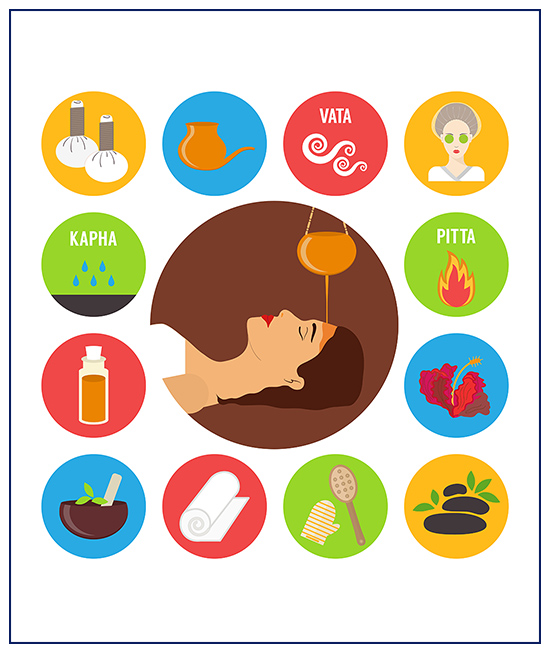
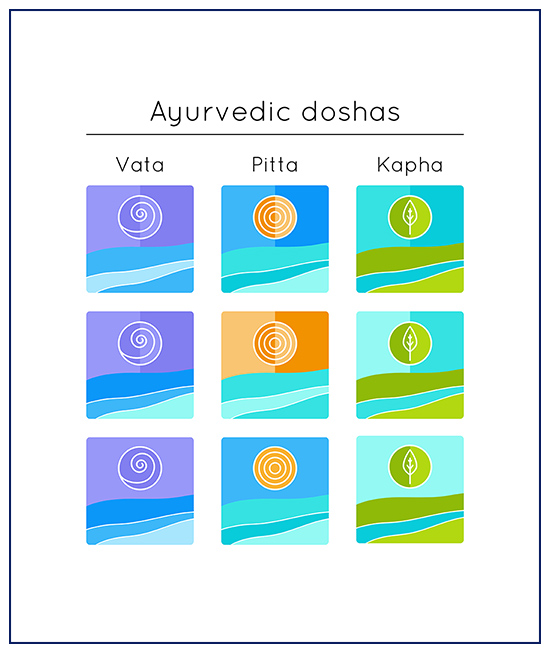
PRAKRUTI IS OUR UNIQUE NATURE
Our natural constitution, the qualities we were born with, is called Prakruti. Qualities are important, not statistics. In Ayurveda there is no generalized criteria for health, individuality is more important for health. Some people need warm atmosphere, others prefer cooler atmospheres, each one is different and individual. Ayurveda works with the individual qualities of the person.
The predominance of elements (space, air, fire, water, earth), gunas (sattva, rajas, tamas) and doshas (Vata, Pitta, Kapha) at the time of conception, and during the time the mother carries the child in her womb, decides the natural constitution, or bio-type, of that individual. Prakruti is formed from the subtle qualities of the five elements.
Vata = Air + Space
Pitta = Fire + Water
Kapha = Earth + Water
Once this proportion is set, generally it remains permanent for the lifespan of the individual.
Understanding the subtle qualities of Vata, Pitta and Kapha
If we understand the subtle qualities of air and space we will find qualities which are cold, dry, light, clear, subtle and moving, these are the main qualities found in a person with Vata constitution, or Prakruti.
In the same way, we find the subtle qualities of fire and water are oily, hot, liquid and sharp; these are the main qualities of a person with Pitta constitution, or Prakruti.
A person of Kapha Prakruti has the subtle elements of earth and water, and gives them qualities that are slow, solid, cool, liquid and dense.
KNOW YOUR CONSTITUTION
- Vata Constitution, Prakruti - basic theme of vata type is “changeable” & unpredictable.
- Body structure - Light- Thin built; Narrow shoulders & or Hips, Less subcutaneous fat; Dry skin, brittle nails. Difficult or impossible to gain weight
- Mental state - Enthusiastic, vivacious, imaginative; quickly grasp new information, quickly forgets; Tendency to worry, excitability, changing moods; Light, interrupted sleep.
- Physiologically - Performs actions quickly; tendency to overexert tires easily; mental & physical energy comes in bursts; Irregular Hunger & Digestion.
- Pitta Constitution, Prakruti - Basic theme of pitta type is “intense”
- Body structure - Medium built, Fair or ruddy skin, Blond, light brown, or red hair (or reddish undertones) Aversion to sun, Hot weather. Maintain their weight, not difficult for them to gain or lose a few pounds at will.
- Mental state - enterprising character likes challenges, sharp intellect, precise articulate speech, Tendency towards anger, irritability under stress
- Physiologically - Medium strength & endurance, Sharp hunger & thirst, strong digestion, cannot skip meals
- Kapha Constitution, Prakruti - Basic theme of kapha type is “Relaxed”
- Body structure - Solid, powerful build; cool smooth, thick, pale often oily skin; tendency to obesity
- Mental state - Tranquil, relaxed personality; slow to anger; slow to grasp new information, but good retentive memory; heavy prolonged sleep; affectionate, tolerant, forgiving; tendency to be possessive, complacent
- Physiologically - Great physical strength & endurance; steady energy, slow & graceful in action; slow digestion, mild hunger.
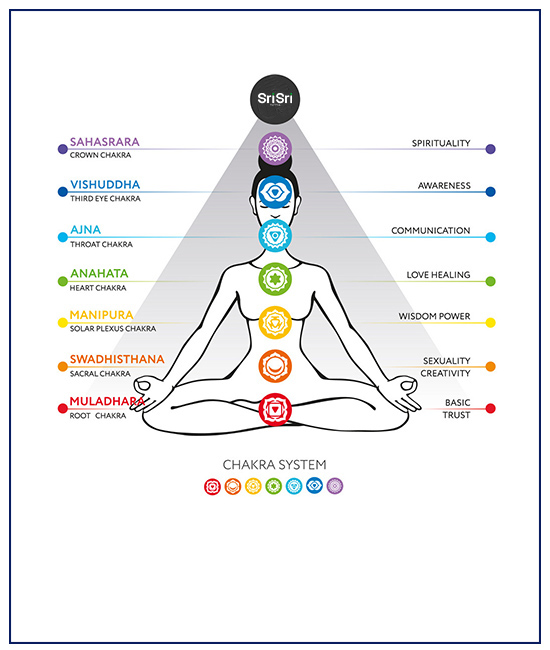
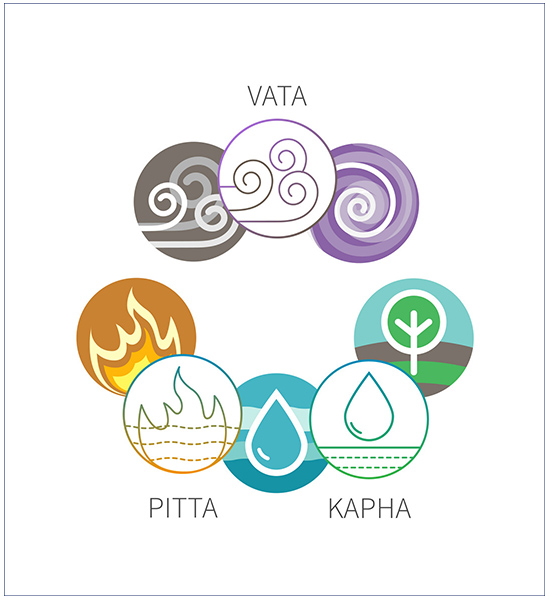
TWO DOSHA TYPE
Everyone is endowed at birth with some of each dosha. What makes it possible to describe “pure” Vata, pitta or kapha is that they have so much of one dosha- they are extremes. However, this is not true of most people. Most people are two dosha types, with one dosha predominant but not extreme. This makes 6 combinations-
- Vata - Pitta
- Pitta - Vata
- Pitta - Kapha
- Kapha - Pitta
- Vata - Kapha
- Kapha Vata
THREE DOSHA TYPE
A rare combination but the best prakruti with the best chance for remaining in balance, A true sama dosha Prakruti will tend to have lifelong good health, ideal immunity & longevity.
On the other hand, it is also held that once imbalances start to occur, 3 dosha types have a disadvantage, because they have to pay attention to getting all three back into line.
As every Prakruti has its own qualities, it has own tendencies for some imbalances
Vata type are more prone to -
- Insomnia, Anxiety & Depression, High Blood Pressure
- Chronic constipation, Nervous stomach, Irritable Bowel
- Muscle spasms or cramps
- PMS (pre menstrual syndrome, Dysmenorrhoea)
- Arthritis
Pitta type are prone to -
- Rashes, Acne
- Heart burn, Peptic ulcers
- Early balding & premature gray hair
- Poor eye sight
- Hostility, Self criticism
- Heart attacks related to stress
Kapha type are prone to -
- Chest Colds, congested sinuses
- Asthma and or allergies
- Depression
- Diabetes, High Cholesterol, Obesity
- Chronic sluggishness in the morning.
- Painful joints
When an illness arises, it manifests first in the thought form, which is the subtlest aspect and then in the sound form. Thereafter it manifests in the light form, that is, in the aura. It is only then that the illness manifests itself in the body. To begin with, simple symptoms arise in the fluid form, which can be eradicated, and then only they manifest in the grossest form, where they need medication. In aroma therapy, an illness can be cured just through fragrance. It is mostly focused on the preventive aspect.
The holistic approach of Ayurveda includes exercising, breathing and meditation. Breath is synonymous to life. For all practical purposes, if someone is not breathing, that's the sign that there is no life there.
